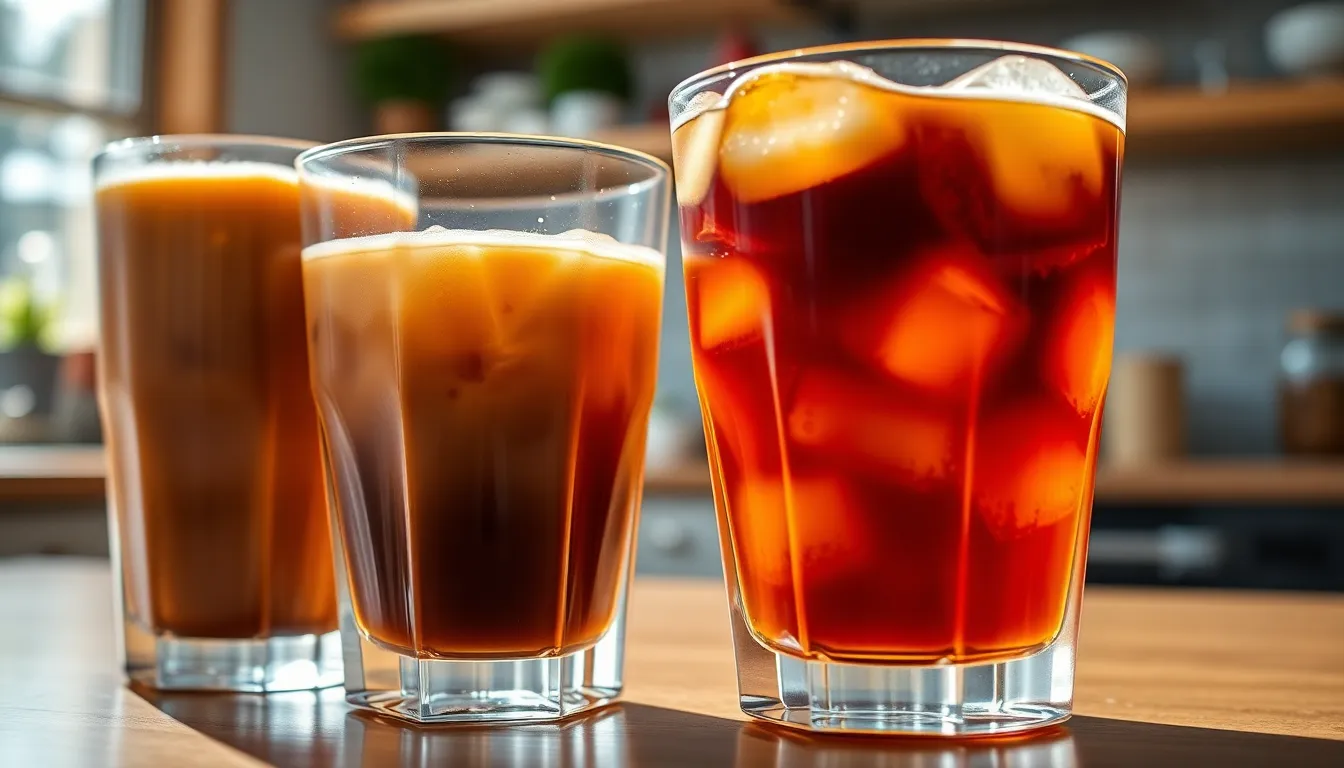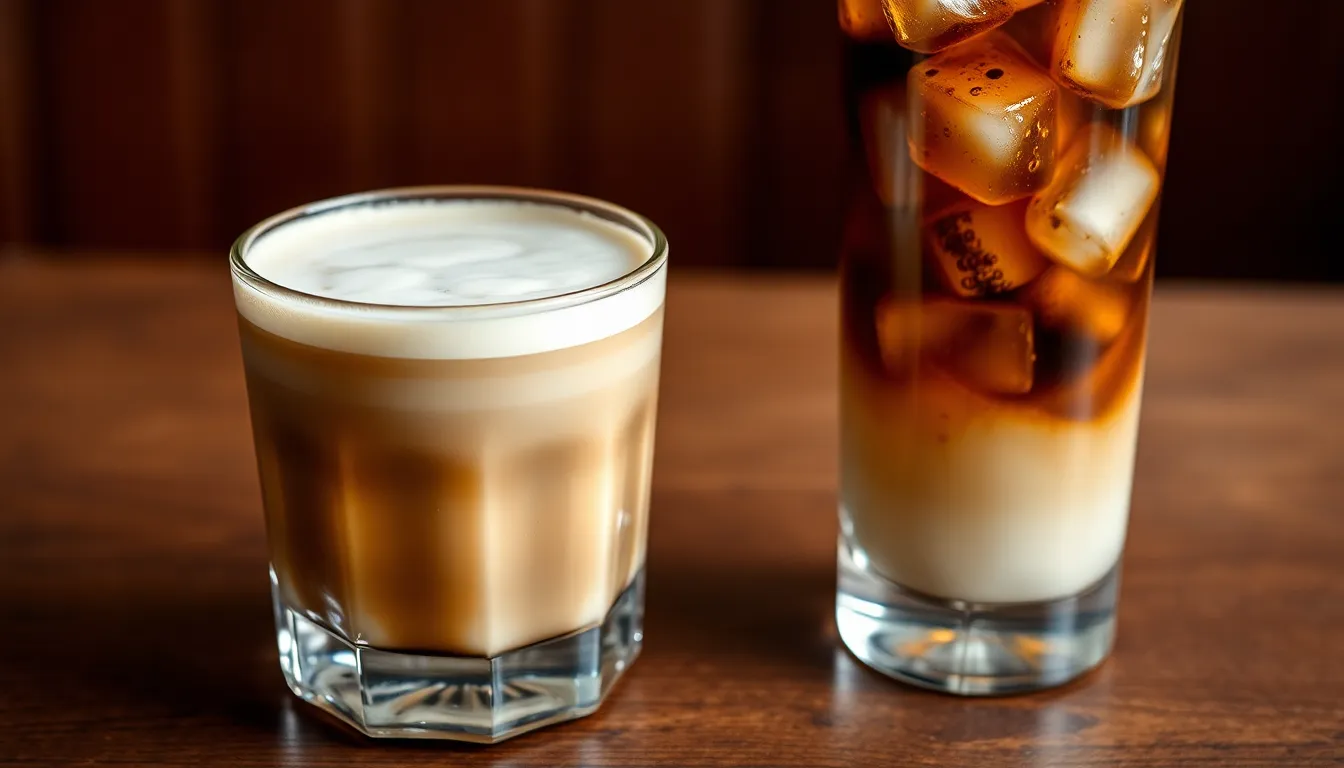Wondering about the difference between a latte and iced coffee? These popular coffee shop staples might seem similar at first peek, but they’re actually quite distinct beverages with their own unique characteristics and flavor profiles.
When you’re standing in line at your favorite café trying to decide between a creamy latte or a refreshing iced coffee, knowing what sets them apart can help you make the perfect choice. From preparation methods and caffeine content to milk ratios and customization options, these coffee drinks offer different experiences for different preferences and occasions.
What’s the Difference Between a Latte and Iced Coffee?
Lattes and iced coffees represent two distinct approaches to cold coffee beverages, differing fundamentally in their composition and preparation. A latte combines espresso with steamed milk and a thin layer of foam, while iced coffee is simply brewed coffee served over ice. These differences extend beyond their basic ingredients, affecting everything from taste to caffeine content.
Ingredients and Preparation
Lattes require exact ingredients and equipment that set them apart from simpler coffee drinks. Espresso machines extract concentrated coffee through finely ground beans under pressure, creating the robust base of a latte. Skilled baristas then add steamed milk in a precise ratio—typically 1:3 or 1:4 espresso to milk—and finish with a thin layer of microfoam. The result is a creamy, balanced beverage with a velvety texture.
Iced coffee follows a more straightforward preparation process. Coffee beans are ground coarsely and brewed using methods like drip, pour-over, or cold brew, then poured over ice. The brewing temperature and time vary depending on the method, with cold brew steeping for 12-24 hours at room temperature or in refrigeration. This simplicity makes iced coffee an accessible option for home brewing without specialized equipment.
Flavor Profiles
The taste experience of these beverages differs dramatically due to their composition. Lattes offer a creamy, mild flavor where the espresso’s intensity is softened by the substantial amount of milk. The microfoam adds a silky texture that complements the rich espresso notes. As Rikki Manny observed while visiting specialty cafés across Seattle, “Lattes provide a gentle introduction to espresso flavors, making them popular with those who find black coffee too harsh.”
Iced coffee presents a bolder, more direct coffee flavor profile. The brewing method influences the taste significantly—traditional hot-brewed methods produce brighter acidity and more pronounced flavor notes, while cold brew yields a smoother, less acidic result with chocolate and nutty undertones. Many iced coffee enthusiasts appreciate this clarity of flavor, unmasked by milk or foam.
Milk Content
Milk plays contrasting roles in these beverages, affecting both nutrition and taste. Lattes contain substantial amounts of milk—about 6-8 ounces in a standard serving—making them richer in calories, protein, and calcium. This milk component creates the signature creaminess and mouthfeel that latte lovers crave.
Iced coffee contains no milk in its basic form, though many people add a splash according to preference. This flexibility allows for customization while maintaining the fundamental coffee-forward character of the drink. The absence of milk in traditional iced coffee makes it naturally lower in calories and dairy-free by default.
Caffeine Content
Caffeine levels vary significantly between these beverages based on their coffee concentration and volume. A standard latte contains 1-2 shots of espresso (approximately 63-126 mg of caffeine), diluted with milk that doesn’t affect the caffeine content but increases the overall volume.
Iced coffee typically delivers more caffeine per serving—about 165 mg in a 16-ounce serving—due to the larger volume of coffee used in its preparation. Cold brew methods often produce even higher caffeine concentrations because of their extended steeping time, sometimes reaching 200 mg per serving. Regular iced coffee drinkers often report experiencing a more sustained energy boost compared to espresso-based drinks.
Customization Options
Both beverages offer extensive customization possibilities, appealing to different preferences. Lattes serve as versatile canvases for flavor additions, with vanilla, caramel, and hazelnut being particularly popular options. Seasonal variations like pumpkin spice or peppermint create limited-time offerings that drive coffee shop traffic during exact times of year.
Iced coffee customizations focus on improving rather than masking the coffee flavor. Common additions include simple syrup instead of granulated sugar (which dissolves better in cold liquid), cream or alternative milks, and flavor shots that complement rather than overwhelm the coffee notes. Many coffee shops now offer signature iced coffee blends with specially selected beans to highlight particular flavor characteristics.
Understanding Lattes: Composition and Flavor Profile

A latte combines espresso and steamed milk in perfect harmony, creating a creamy beverage with a mellow flavor profile. The signature balance of this popular coffee drink features a strong espresso foundation softened by a generous amount of milk, resulting in less bitterness and a rich, velvety mouthfeel.
How Lattes Are Made
Lattes begin with one or two shots of espresso, a concentrated coffee brewed under high pressure. Baristas pour this espresso into a cup, then add steamed milk in approximately a 1:2 ratio—one part espresso to two parts milk. The milk undergoes a careful steaming process that creates microfoam, giving lattes their signature silky texture. Many cafés finish the drink with a light layer of foam on top, improving both texture and visual appeal. Iced lattes follow a similar principle but with a temperature twist; slightly cooled espresso shots are poured over ice before adding cold milk, maintaining the creamy consistency while delivering a refreshing chill.
Typical Latte Characteristics
Lattes boast a remarkably smooth and creamy texture thanks to their high milk content. The flavor profile presents a milder coffee taste compared to other espresso drinks because the milk dilutes the intensity of the espresso. These drinks frequently incorporate sweeteners or flavored syrups, particularly in iced variations, which significantly increases their caloric and sugar content compared to plain coffee options. The balanced nature of lattes makes them approachable for coffee newcomers while still satisfying experienced enthusiasts who appreciate the nuanced interplay between espresso and milk. The versatility of lattes extends to temperature preferences, working equally well as a comforting hot beverage or a refreshing cold drink depending on seasonal preferences.
Exploring Iced Coffee: Types and Preparation

Iced coffee offers a refreshing alternative to hot coffee with various preparation methods that affect its flavor profile. Understanding the differences between iced coffee varieties helps you choose the perfect cold caffeine fix for your taste preferences.
Cold Brew vs. Regular Iced Coffee
Cold brew coffee undergoes a completely different extraction process than regular iced coffee. Regular iced coffee starts as hot-brewed coffee that’s cooled and poured over ice, creating a quick refreshment with familiar coffee characteristics. This method preserves the bright acidity and full-bodied flavor of traditionally brewed coffee while delivering it in a chilled form.
Cold brew, by contrast, steeps coarsely ground coffee beans in cold water for 12-24 hours, producing a concentrate that’s diluted before serving. The extended steeping time extracts coffee compounds gradually without heat, resulting in approximately 67% less acidity than hot brewing methods. Many coffee enthusiasts, including our regular customer Rikki Manny, have switched to cold brew after discovering its smooth character doesn’t upset sensitive stomachs the way regular iced coffee sometimes can.
The preparation tools differ significantly between these methods. Regular iced coffee requires only standard coffee-making equipment followed by cooling, making it accessible for home brewing. Cold brew necessitates more patience but fewer specialized tools – a simple mason jar and strainer can produce excellent results with minimal effort.
Flavor Notes in Iced Coffee
Iced coffee varieties showcase distinct flavor profiles based on their brewing methods. Cold brew typically exhibits pronounced chocolatey, nutty, and sometimes fruity notes due to its gentle extraction process. The absence of heat prevents the release of certain compounds that contribute to bitterness, allowing the coffee’s natural sweetness to shine through.
Regular iced coffee maintains brighter, more acidic flavors characteristic of hot extraction. These vibrant notes include citrus, berry, and floral undertones depending on the coffee’s origin. The rapid cooling process preserves these distinctive qualities while providing the refreshment of a cold beverage.
Coffee origin dramatically influences the flavor profile regardless of preparation method. Ethiopian beans often contribute berry and wine-like notes to iced coffee, while Colombian varieties add caramel and chocolate dimensions. Brazilian beans produce nutty, chocolate flavors that particularly complement cold brew preparations.
Serving methods also enhance different aspects of iced coffee’s flavor profile. Adding a splash of milk softens acidity in regular iced coffee, while cold brew’s natural smoothness pairs beautifully with simple syrup or vanilla for subtle sweetness without masking its complexity.
Nutritional Comparison: Latte vs Iced Coffee

Understanding the nutritional differences between lattes and iced coffee helps you make choices that align with your dietary preferences. These popular coffee beverages vary significantly in their caloric, caffeine, and nutrient profiles.
Calorie Content
Lattes contain substantially more calories than plain iced coffee due to their milk content. A standard iced latte made with whole milk typically contains between 120-190 calories per serving, while versions made with plant-based alternatives like almond or oat milk range from 60-120 calories. Black iced coffee, in contrast, is virtually calorie-free at just 0-5 calories per serving. Adding cream, sugar, or flavored syrups to iced coffee can quickly escalate the calorie count to 100-300+ calories, putting it on par with or exceeding a latte’s calorie content.
Caffeine Levels
Iced coffee delivers a stronger caffeine punch than lattes in most cases. A typical 8-12 oz serving of iced coffee contains between 95-200 mg of caffeine due to its higher coffee-to-water ratio. Lattes offer a more moderate caffeine experience since the espresso is diluted with milk – a single-shot latte provides approximately 64 mg of caffeine, while a double-shot version contains around 128 mg. This difference makes iced coffee the preferred choice for those seeking maximum caffeine impact.
Additional Nutritional Points
- Protein: Lattes offer approximately 8g of protein per serving thanks to their milk content, while black iced coffee contains minimal protein.
- Calcium: The milk in lattes provides important calcium benefits (about 158 mg per serving) compared to iced coffee, which lacks calcium unless milk is added.
- Fat and Sugar: Lattes naturally contain more fat from milk and often more sugar from flavored syrups. Plain iced coffee contains negligible amounts of both unless additions are made.
| Nutrient | Latte | Iced Coffee |
|---|---|---|
| Calories | 120-190 (whole milk) | 0-5 (black) |
| 60-120 (plant milk) | 100-300+ (with additions) | |
| Caffeine | 64 mg (single shot) | 95-200 mg per 8-12 oz |
| 128 mg (double shot) | ||
| Protein | ~8 g | Minimal |
| Calcium | ~158 mg | Minimal unless milk added |
| Fat & Sugar | Higher (from milk) | Low when black |
Customization Options for Both Beverages

Both lattes and iced coffee offer extensive customization possibilities, letting you create a drink that perfectly matches your taste preferences. These coffee beverages serve as blank canvases for flavor experimentation, with many ways to personalize your cup.
Latte Customization
Lattes provide multiple customization avenues starting with milk selection. You can choose from traditional dairy options like whole, skim, or cream, or opt for non-dairy alternatives such as oat, almond, or soy milk to accommodate dietary preferences or restrictions.
Flavor enhancement comes through various sweeteners and syrups. Vanilla, caramel, hazelnut, mocha, and seasonal spice syrups transform a standard latte into a personalized treat. Adjusting sweetness levels is simple by requesting more or fewer pumps of syrup.
Temperature variations expand your options further. Though traditionally served hot, lattes adapt well to cold preparations as iced lattes, combining espresso, milk, and ice for a refreshing chilled version.
Toppings complete the customization experience. Whipped cream, cinnamon, nutmeg, and caramel or mocha drizzle add flavor dimensions while improving the visual appeal of your latte.
Iced Coffee Customization
Iced coffee customization begins with selecting your coffee base. Options range from standard brewed coffee to concentrated espresso shots, cold brew, or espresso poured over ice, each providing different flavor intensity and caffeine content.
Milk and cream additions mirror latte options, encompassing all dairy varieties and plant-based alternatives. The fat content can vary from light to heavy cream depending on your preference for richness.
Sweetener choices for iced coffee are particularly diverse. Classic simple syrup dissolves better than granulated sugar in cold drinks, while flavored syrups like vanilla, caramel, brown sugar, and toffee nut create signature flavor profiles. Sweet cream toppings, especially vanilla sweet cream cold foam, add another dimension.
Flavor add-ins and spices personalize iced coffee further. Cinnamon, nutmeg, mocha drizzle, and caramel sauce layer flavors throughout your drink.
Creative add-ons complete the iced coffee experience. Popular combinations at coffee shops include Mocha Toffee Iced Coffee, Vanilla Sweet Cream Classic Iced Coffee, Brown Sugar Iced Coffee, and Caramel French Vanilla Iced Coffee, featuring unique blends of syrups, creams, and drizzles.
| Feature | Latte | Iced Coffee |
|---|---|---|
| Coffee Base | Espresso | Brewed coffee or espresso |
| Milk Type | Steamed milk (any dairy/non-dairy) | Milk or cream (dairy/non-dairy) |
| Temperature | Hot or iced | Cold, served over ice |
| Flavorings | Syrups (vanilla, caramel, mocha) | Syrups, sweet creams, spices |
| Sweeteners | Added via syrup or sugar | Classic syrup, flavored syrups |
| Add-ons | Whipped cream, drizzles, spices | Whipped cream, cold foam, drizzles |
Iced coffee generally offers broader customization flexibility due to its adaptable coffee base and serving style, while lattes highlight the creamy texture from the combination of steamed milk and espresso. Both drinks allow you to adjust sweetness, milk type, and additional flavorings to create a personalized coffee experience that suits your unique taste preferences.
When to Choose a Latte vs Iced Coffee

Your coffee choice reflects your personal preferences and circumstances. Knowing when to opt for a latte versus an iced coffee can enhance your coffee experience based on exact needs and situations.
Seasonal Considerations
Seasonal temperatures significantly influence coffee preferences. During warmer months (spring and summer), iced coffee provides a refreshing, crisp caffeine boost without milk’s heaviness, making it more thirst-quenching and revitalizing. The lighter consistency of iced coffee feels particularly satisfying when temperatures rise, offering that perfect balance of cooling refreshment and energizing caffeine.
Conversely, fall and winter months call for the comforting richness of lattes. The creamy texture and warming qualities of a latte complement colder weather, creating a cozy experience that many coffee drinkers crave during chilly seasons. Even iced lattes maintain that creamy indulgence while adapting to personal temperature preferences year-round.
Flavor Preferences
Your taste preferences play a crucial role in deciding between these two coffee options. Choose a latte when you crave a smooth, creamy beverage with a milder coffee intensity. The generous milk content creates a velvety texture that softens the espresso’s strength, resulting in a balanced, dessert-like coffee experience. Lattes also serve as excellent vehicles for added flavored syrups or seasonal specialties.
Opt for iced coffee when you desire a bolder, more robust coffee flavor with pronounced caffeine effects. The purity of iced coffee highlights the natural characteristics of the brew, offering a straightforward coffee experience with minimal dilution. Coffee purists appreciate how iced coffee showcases the bean’s origin flavors and complexity without the masking effect of abundant milk.
Also, calorie considerations might influence your choice – lattes contain higher calorie counts due to their milk content, while iced coffee, especially when consumed black, offers a virtually calorie-free option. For those seeking a stronger caffeine kick with fewer calories, iced coffee provides the ideal solution, delivering approximately 95-200mg of caffeine compared to a latte’s 64-128mg.
Popular Variations Around the World

Coffee culture varies dramatically across different regions, with each country adding its unique twist to classic beverages like lattes and iced coffee. These regional adaptations reflect local tastes, ingredients, and traditions that have evolved over decades of coffee consumption.
Italy, the birthplace of espresso, serves the traditional hot “caffè latte” with perfectly steamed milk. During summer months, Italians cool down with “latte freddo,” a refreshing combination of cold milk and espresso that maintains the authentic Italian coffee experience without the heat.
United States coffee shops have transformed lattes and iced coffee into highly customizable beverages. American iced lattes frequently include flavored syrups such as vanilla, caramel, or hazelnut, while iced coffee comes in various forms from sweetened to completely black, catering to diverse preferences.
Southeast Asian countries like Vietnam have developed distinctive iced coffee varieties that use sweetened condensed milk. Vietnamese iced coffee (cà phê đá) combines strong brewed coffee with sweetened condensed milk over ice, creating a rich, sweet flavor profile that complements the region’s typically dark, robustly roasted beans.
Australia and New Zealand have contributed the flat white to global coffee culture, featuring espresso with minimal milk foam. Iced versions of this drink maintain the higher coffee-to-milk ratio, resulting in a stronger coffee flavor compared to traditional lattes while still offering creamy texture.
Japanese iced coffee preparation focuses on precision and quality. Their cold coffee is typically brewed using pour-over methods and then rapidly chilled to preserve aromatics. Japanese coffee shops often serve this smooth brewed coffee black or with minimal additions, emphasizing the natural flavors of the beans.
These global variations highlight the fundamental difference between espresso-based iced lattes and brewed coffee-based iced drinks. While the core ingredients remain similar, local preferences for sweetness, milk content, and brewing methods create distinctly different experiences across cultures.
Conclusion
Both lattes and iced coffee offer unique experiences for coffee lovers even though their surface similarities. Your preference will likely depend on whether you crave the creamy richness of a milk-forward latte or the bold refreshing quality of iced coffee.
Consider your priorities when choosing between these beverages. Lattes deliver a seamless process with balanced flavors while iced coffee provides stronger caffeine content with fewer calories. The customization options for both drinks mean you’ll never run out of variations to try.
Whether you’re cooling down on a summer day with a crisp iced coffee or enjoying the velvety texture of a perfectly crafted latte you’re now equipped to order exactly what satisfies your coffee cravings.
Frequently Asked Questions
What is the main difference between a latte and iced coffee?
A latte combines espresso with steamed milk and foam, resulting in a creamy, balanced beverage. Iced coffee is simply brewed coffee served over ice. While lattes have a mild, creamy taste due to their high milk content, iced coffee offers a bolder coffee flavor with virtually no milk unless added separately.
Which has more caffeine, a latte or iced coffee?
Iced coffee typically contains more caffeine than a latte. A standard serving of iced coffee provides approximately 95-200mg of caffeine, while a latte contains about 64-128mg. This difference occurs because iced coffee uses a higher coffee-to-water ratio than the espresso shots in a latte.
Are lattes or iced coffee better for weight management?
Iced coffee is generally better for weight management as it’s virtually calorie-free when served black. A standard iced latte contains between 120-190 calories due to its milk content. If you’re watching your calorie intake but still want a creamy texture, consider adding a splash of low-fat milk to iced coffee instead.
How is cold brew different from regular iced coffee?
Cold brew is made by steeping coarsely ground coffee in cold water for 12-24 hours, resulting in a smooth, less acidic concentrate. Regular iced coffee is made from hot-brewed coffee that’s cooled and poured over ice. Cold brew typically has chocolatey, nutty notes, while regular iced coffee retains brighter, more acidic flavors.
Can I make a latte or iced coffee at home?
Yes, both can be made at home. Iced coffee is simpler—brew coffee, let it cool, and pour over ice. For a latte, you’ll need espresso (or strong coffee as a substitute) and a way to steam milk. An iced latte requires espresso poured over ice with cold milk. Basic versions require minimal equipment beyond what most kitchens already have.
Which offers more customization options, lattes or iced coffee?
While both beverages are highly customizable, iced coffee generally offers broader flexibility. Lattes highlight the creamy texture from steamed milk and espresso, with customization through milk type, flavored syrups, and toppings. Iced coffee’s adaptable coffee base allows for various preparations (brewed, cold brew, espresso-based) and accommodates more add-ins without compromising its essential character.
How do nutritional values compare between lattes and iced coffee?
Lattes contain substantially more calories and nutrients than black iced coffee. A standard latte provides about 8g of protein and 158mg of calcium from milk, with 120-190 calories. Black iced coffee has virtually no calories, protein, or calcium. However, iced coffee typically delivers more caffeine, ranging from 95-200mg per serving compared to a latte’s 64-128mg.
When should I choose a latte over iced coffee?
Choose a latte when you want a smooth, creamy beverage with a milder coffee flavor, especially during colder weather when its warmth is comforting. Opt for iced coffee when you prefer a stronger coffee taste, need higher caffeine content, are watching calories, or want a refreshing cold drink during warmer months.
































